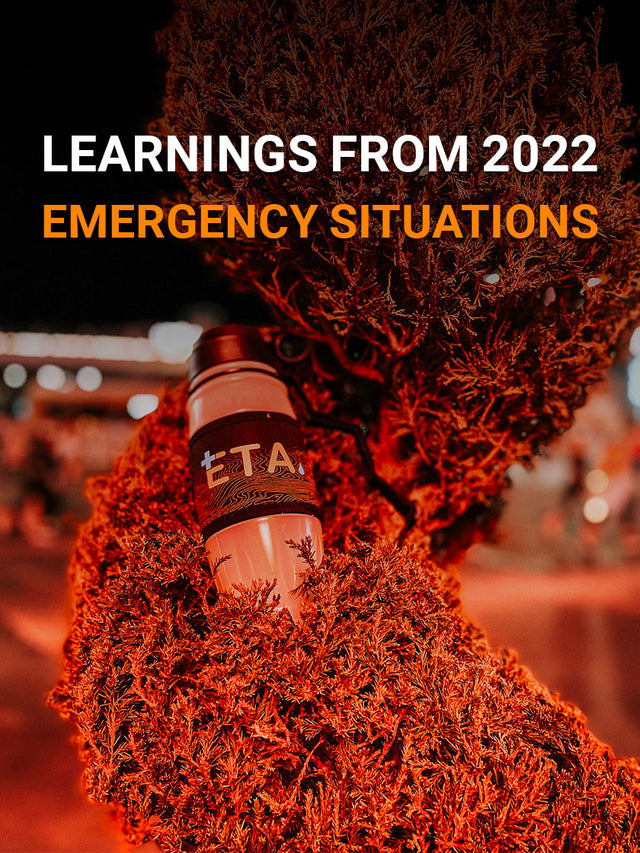
Learnings from 2022 Emergency Situations
The year 2022 was not the easiest year. Amidst the aftermaths of COVID and other scorching seasons of emergencies, many will remember it for the challenging year it was. With many disasters and emergencies taking place throughout the year, people were challenged with different types of extreme weather conditions resulting in loss of lives and assets, health conditions, and other turbulences to the normal course of life.
Even in the recent few months, weather conditions not only in the United States but around the whole world have become more extreme due to global warming, resulting in a string of unpredictable and unheard of weather conditions that lead to catastrophic or even fatal outcomes.
A snapshot of what happened in the USA
In the United States, 2022 will be known for its severe storms and flooding as well as its harsh heat waves and droughts.

By October, the United States had faced around 15 natural disasters with an average cost of more than US$1 billion in damages. From Texas to Maine, there were numerous severe winter storms at the beginning and the close of the year that affected tens of millions of people and left substantial damage in their wake. Then, with 233 recorded tornadoes in March, the previous records of disasters was broken.
Moreover, 1,000-year rainfall events happened over the course of five weeks in the summer, resulting in destructive and devastating flash floods in St. Louis, eastern Kentucky, southern Illinois, Death Valley in California, and Dallas. And also, Mississippi's severe flooding cut off Jackson's problematic water supply for weeks resulting in severe problems with drinking water and health issues. Large portions of Yellowstone National Park had to be evacuated due to a catastrophic flood in Montana that was caused by persistent rain and melting snow.
Hurricanes Ian and Fiona inundated Florida and Puerto Rico in the fall with a devastating, damaging storm surge and over 2 feet (6.6 meters) of rain in some places. Ian ended up being one of the costliest hurricanes in American history. And a typhoon battered the 1,600 km (1,000 mi) long Alaskan shoreline.
Contrasting weather conditions
While much rainfall put some areas in danger, intense or high heat and inadequate precipitation increased concerns in other areas of the county.
Many regions of the country experienced extended heat waves that broke temperature records. In the midst of the worst mega drought the Southwestern United States has seen across at least 1,200 years, wildfires burned in Arizona and New Mexico.
In the fall, the Mississippi River in Memphis was so low due to drought that boats needed additional dredging and upstream water releases in order to pass. This delayed the transportation of grain during the crucial harvest season. As the water levels in the major reservoirs approached dangerously low levels, officials along the Colorado River contemplated even stricter water use restrictions.

Climate change is making these catastrophes worse
The frequency and intensity of extreme temperature and precipitation events have increased significantly, according to the most current global climate assessment from the United Nations Intergovernmental Panel on Climate Change, which has increased the frequency and intensity of droughts and floods.
According to a report from 2022, despite increased ability to control climate risks, extreme flooding and droughts are also becoming deadlier and more severe. Therefore, it is a major fact that climate changes have made today's extreme events more frequent and unpredictable.
Climate models predicts the extreme weather
A large portion of extreme conditions are fully understood and are reliably reflected by climate models. More extreme conditions may result from a change in temperature distribution as the climate warms up. For instance, a 1 degree Celsius increase in the annual average temperature corresponds to a 1.2 to 1.9 degree Celsius (2.1 to 3.4 degree Fahrenheit) increase in the annual maximum temperature.
Additionally, the atmosphere and ocean's motion are altered as a result of global warming. Global wind is caused by the temperature differential between the equator and the poles. The lessened temperature difference causes the global winds to weaken and the jet stream to become more meandering as the polar areas warm much faster than the equator.
Some of these modifications can lead to the development of atmospheric blocking and persistent high pressure systems, which can result in more extreme heat waves. As an example, the heat domes that covered the Southern Plains and South in June and the West in September.
Action plan for 2023
- Be prepared for the known and the unknown
Because natural disasters occur more frequently each year, everyone should be ready. Visit government websites like Ready.gov, the National Oceanic and Atmospheric Administration, and the Centers for Disease Control and Prevention to learn more about how to reduce risks to life and property in the case of any major disaster.
Preparing also includes securing your homes, property, important documents and other essentials that are at risk due to emergencies.
- Do safety drills
Create a safety plan with your family, especially with your children, and practice it before implementing it. Create a disaster kit with all the needs, including water, food, medicine, and other survival supplies.
- Promote community preparedness
Consider volunteering at the Red Cross, at your neighborhood watch, at the nearby fire station, or even at the Citizen Corps to get a better idea of how your skills might be put to use.
- Maintain awareness and knowledge to stay ahead.
Always be sure to stay current on the news. A solid awareness of our location and geography is also crucial for safety and readiness so that you can determine whether you reside in a region that is vulnerable to a specific type of disaster that recurs.
Importance of ETA with extreme weather conditions
With all these extreme weather conditions, water is one of the first things to get contaminated with the water system being damaged and becoming unhygienic to use. Contact with those water systems can lead to severe health conditions like diarrhea and prolonged usage to more severe health conditions. Hence, the ETA Alkaline Water Filter Bottle was invented to help people to overcome these situations and have proper hydration while bulletin emergency preparedness.

Now that filtration and purification technology has advanced, you can carry your own filter water bottle anywhere around the world, no matter the situation, and face any emergency without putting your and your family’s health at risk.
This technology-backed filtration bottle is the most "TESTED and TRUSTED" product of its kind in the world. Its groundbreaking IAMF Technology (Ionic Adsorption Micro Filtration), powered by a one-of-a-kind filter, removes up to 99.99% of harmful and life-threatening contaminants from water in ALL 4 categories of contamination zones that include aesthetic, chemical, dissolved solids, and radiological contaminants, turning filthy water into clean, safe water and essentially turning the unthinkable into drinkable H2O. Our filter concurrently creates alkaline water from the purified water. The sophisticated filtration method also protects the water's essential nutrients and mineral content and has become the best option to backup during any sort of emergencies.
Adjusting to the new normal
Due to the increase in frequency of these extreme climatic changes, this year may offer a glimpse into the near future. But to claim that this is the "new normal" is deceptive. It implies that we have arrived at a new stable state, which is untrue.
Therefore, it is important to learn from the happenings in 2022 to back up, prepare and arm ourselves to face any major disaster or emergency situation that may arise in 2023. Future is unpredictable, all we can do is be prepared to face anything.
